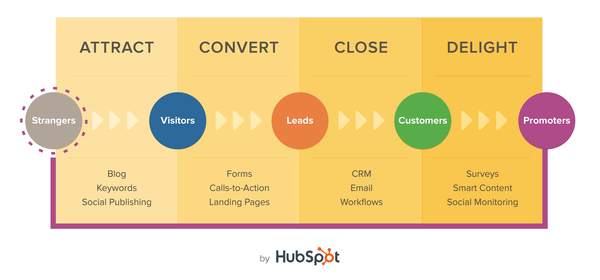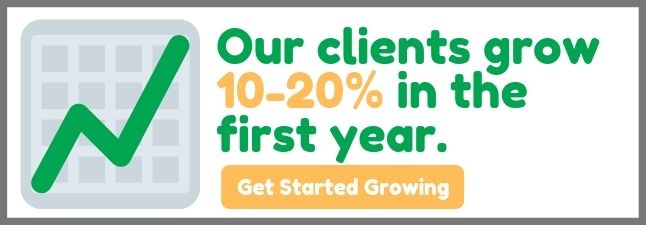Posted by Todd Hockenberry ● Oct 25, 2016
Generate Warm Leads by Skipping the Cold Starts
In today’s changing world we receive so many sales and marketing messages that we all have become immune to the noise. Estimates vary but the average person receives, in one form or another, up to 1,000 marketing messages every day. Our mobile devices and apps help us have access to information at any time and help us filter out what we don't want to see. Nobody is listening to you, but they are searching.
Business owners constantly complain to me that no one answers their phone, you can't reach the decision-maker, my sales team is not getting it done. What changed? What can we do about it?
 Traditional outbound marketing tactics are alive but are not doing so well:
Traditional outbound marketing tactics are alive but are not doing so well:
-
We ignore most things that arrive by mail, too busy to really read them (most of my snail mail goes in the recycling bin before I get back inside)
-
We delete emails without even bothering to read the subject line much less the body of the message. It’s all spam anyway unless you become a trusted source
-
We barely have time to do our jobs much less go to trade shows. And if we do manage to get one day at a show we have time for only a quick run-through at best. There's no time to really think about what we are seeing.
-
Trade magazines - Forget it, we may read the e-newsletters that hit our inbox but to actually sit down and read a magazine? Doesn't happen
People are not listening to your marketing chatter and they are actively finding ways to stop you from ever talking to them or even getting your messages. There are no easy ways to generate real qualified leads in this or any future market. There are no special lists that you can buy that will magically hold the hundreds of customers that are dying to buy from you.
Socrates’ guiding rule was ‘know thy self’ and it is in this timeless principle that we see the only way forward: sustainable inbound-driven lead generation that translates to real growth.
Inbound lead generation begins and ends with knowing your strengths and how you and your company create value for your target audience. High return leads come from prospects that have the need that your product or service fulfills. Great leads come from knowing how to attract them by using content that is of interest to them. Based on their needs.
They ask questions and your content should answer them.
Notice I did not say “who your company can sell to”. Jeffrey Gitomer says it best, “People don’t want to be sold, but they love to buy!™”. Successful companies create an environment where people want to buy. This is best done by delivering valuable content first that demonstrated that you understand their needs.
Before moving on to the specifics of creating a high return inbound leads campaign, we need to be clear on what we are not talking about.
Regularly generating high return leads does not happen when a company relies on passive lead generation. Passive leads are generated by the prospect stumbling onto you at a trade show, seeing your listing on an internet catalog (sites like ThomasNet, GlobalSpec or Direct Industry), or waiting for the phone to ring. Sure, you will get some leads and close some sales this way, but more often than not when the phone rings or someone contacts you for the first time through a contact us form on your web site you are just filling folders full of second and third quotes and losing to the guy who got there first.
Only 3% of B2B buyers are ready to buy at any given time. 40% are poised to begin and 56% are not ready.
Like one of my sales mentors used to say, “Son, we do not sell quotes here”. Do not get into the trap of selling quotes to the 3%. You need to reach them before they are ready to buy, that is unless you think you sell a commodity or have a low consideration product or service that people can buy with little effort.
High return leads come from a proactive inbound marketing and sales campaigns, regularly applied by a company that understands the target customer, knows the answers to the questions that the customer will ask, and answers them with a team qualified and equipped to communicate your value to the target customers.
Inbound Marketing and Sales
What is Inbound Marketing? Here is a good article but, in short, it is creating great marketing that people want to consume as opposed to interrupting them in the hope that they might be interested. Inbound marketing properly applied attracts target prospects with great content, helps convert them to leads so you can talk to them and help them, ultimately assists them to a purchase, and keeps them happy and coming back for more.
The 'why' of creating an inbound strategy is that 93% of B2B purchases start with an Internet search. If you want revenue growth in the B2B world then you need to have a plan to get found online and to engage with prospects when, where, and how THEY want to be engaged with the right information.
Building an Inbound Marketing Strategy is the 'How' question being answered. The 'What' question is the tactics and specifics of the program as you implement an inbound marketing strategy.

Read about creating an Inbound Marketing Strategy
Understand the Target Customer
The first thing to remember is that proactive means regular, intentional, and specific action designed to achieve a goal. In this case, a program designed to yield a high return of inbound leads that grow your business.
A huge mistake people make is to forget to understand who your customers are. Of course, you know their names and where they are located but do you really know them?
I once asked one of the salesmen on my team to call all of his customers and ask them why they bought from us. A few weeks went by and I asked what he had found. He actually told me he was afraid to call and ask for fear of what they would say! He had so little confidence in himself and our company that he could not bring himself to ask and hear the answer to that most important question, “why did you buy from me”? He was afraid that they might change their minds!
Is your company any better than that? Do you know what your ideal customer profile (the type of company, industry, size, locations, etc) really is? Do you know your buyer persona (the role within your ideal customer that actually buys or influences the decision)? Have you done primary research with your target audience? Do you interview lost sales?
This effort alone will point you in the direction of finding more customers faster than just about anything else. Create a detailed ideal customer profile and buyer persona so that you know specifically who has been buying from you and what value you actually deliver to them.
We think we know the answers but are often surprised when we ask just what exactly our company is really delivering in terms of value. We think it is the price when it was really your service, or product features when it was really response time. Make no assumptions – know in detail why your customers bought from you and what unique value you bring to the marketplace.
Once you know the ideal profile of the target customer you can begin to compile the list of target companies that you want to approach.
There are many places to find information beyond the obvious (LinkedIn, Google, industry associations, Hoovers, D&B on your target customers including:
- Trade press – I love to read ads to find target companies, rarely to buy anything
- Other companies in your market space – find ways to come up with a win/win situation where you exchange contacts – agree to mention each other in your customer newsletters or in your e-mail updates to your database
- Networking – get your entire company involved, offer rewards for new contacts at target companies
- Local business associations or trade groups – get to know the leaders of the association and ask for referrals to target companies
- Local, state, and national politicians and their staffs - they know everyone and are always willing to make connections, though you will be asked for donations and will be put on mailing lists. Come on, they are politicians, what would you expect?
Know the Answers to the Questions the Customer Will Ask
High return leads come when you understand an industry and the issues they face and why you and your products are best suited to solve the problem. Content that answers their questions allows you to attract and engage with the 40% of your prospects that are poised to be on the buying journey.
If you identify the target customer’s needs early on then there will be much less time spent in qualifying, which shortens the sales cycle and frees you to close more business. Your content needs to change to match the changes the target audience is seeing:
- If there is a new specification, government regulation, or industry-standard how does your offering bring clients into compliance?
- If your product eliminates or lowers a cost or expense, reduces the time needed to complete a job, or improves quality then state, with data, the results your customers should expect (use a referral or a success story for the greatest impact).
- If there is a new trend in technology or product adoption then communicate how your product or service delivers results for the companies most affected.
Simply stated, the world is always changing; you must anticipate where the trends are leading and be ready when those affected by those changes require your help. Customers only care about their problems and you better know how to relate your offering to their specific needs. Just selling a general-use tool and hoping that your target customers can figure out how to use it is a recipe for mediocrity.
A call center I inherited would call targets and ask if they had any need for a laser. As you might expect the response rate was very low since many targets did not see any need for a laser. When the questions changed to a needs focus the results improved significantly. The call center started to ask if the target used any labeling or identification for their parts or if they did any engraving. Once the target answered ‘yes’ then the call center could show how a laser would potentially solve those and other problems.
If your tool or service solves their problem then put the dots close together for them and do the work to create answers/literature/case studies/white papers/web pages/sell sheets/videos/success stories or whatever gets the point across that you understand, empathize, and have the expertise to actually make it all better.
Most ad and marketing copy is written from the seller’s point of view and never makes the leap for the customer and tells them what is in it for them. All you have to do to see this is pick up the latest trade magazine on your lobby coffee table and see for yourself. Everyone talks about being customer-focused, but read trade journals, websites, and just about any other trade-oriented publication and you will see that most companies still talk about features or technology and never seem to get around to stating their case from the customer’s point of view.
Offer info that your targets will value in ways that they want to see and hear it.
Applied By an Inbound Team
The marketing and sales team must be knowledgeable - remember that the goal is to communicate your value and you only get one chance (not just to make a good first impression but one chance, period).
Your content must be optimized, promoted, shared, and amplified online and in your personal interactions with prospects.
If you're not sure how to get marketing and sales on the same page, here is an article I wrote for HubSpot about getting marketing and sales to work together.
The team must be good listeners – the 80/20 rule of listening time to talking time applies. Same with your content. It should be at least 80% from the customer's point of view about the issues that they face, and 20% or less about you, your product, and your features.
The team must have great phone and writing skills. Do not throw your account reps to the wolves unless you know they are good. Test for these skills prior to hiring, train regularly, monitor communications with targets and give regular feedback as to performance and proficiency.
The team must regularly follow up so that you are viewed as a valuable resource when they are ready to buy. You may get lucky and hit a few targets that are ready to buy immediately (the 3%) but most targets will need regular contact to keep them focused on your company until they are ready to buy.
The team must use call outlines that are interesting and get to the point. Do not let your team ‘wing it’. Build email templates, analyze their open rates and engagement, share content with salespeople, and teach them how to use it to personalize their touches with the right context. Practice your delivery and answers to questions before you start talking to customers. Make your mistakes in practice, not in front of potential high return leads.
Use e-mail to warm up the target companies and prospects. Use links to your website, videos, and testimonials relevant to the target industry’s customers in your e-mail and mail pieces.
Use email to share relevant information and to be helpful. 74% of buyers choose the company that was the first to add value. The first one to be HELPFUL!
What Has Changed
What has changed is that outbound passive lead generation is increasing in cost with reduced returns.
Catalog websites are a dime a dozen, no one reads trade publication ads, trade shows are less and less effective, and unfocused marketing efforts are filtered out and deleted in an instant. People are changing how they process information, just think about how Google changes your life. People are multitasking more than ever. They are crunched for time. Information is everywhere but how does it help them make decisions? Millennials don't think like you do. Businesses that share rides, cars, houses, bikes - the very idea of what a business is, is changing.
Creating a customer is different now.
- 93% of all B2B purchases start with an Internet search
- 70% of the buying process is over before a buyer talks to a salesperson
A proactive inbound marketing effort is a high return, lead generation strategy that never ends, but is always updated and improved, and is the best way in the current and future marketplace to build the sales pipeline required for consistent revenue growth.
Topics: Sales, Marketing, Manufacturing







